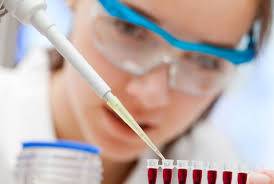It won't show up directly , but the blood tests will show that there is a problem with the liver enzymes. Then they do an ultrasound or a biopsy to tell the actual condition of the liver.

My father is currently being tested for a liver problem. He has had blood tests but apparently they no longer do liver biopsies (he had one 20 years ago). So they will do a scan (they have not stated which kind yet, but Rooster is probably correct that it would be an ultrasound scan).
Another test that is often carried out to detect liver problems is an endoscope examination (a small camera is passed through the mouth, down into the food pipe and into the stomach).
In general, blood tests can show potential problems but more tests are usually required to establish a through diagnosis.
I recently had routine blood tests which showed a high glucose level. This alone was not enough to diagnose diabetes, but it was an indication. Therefore, I was sent for more in-depth tests at the hospital.
Blood tests are invaluable for highlighting potential problems early!
Cirrhosis of the liver is diagnosed through several methods:
Physical exam: During a physical exam, your doctor can observe changes in how your liver feels or how large it is (a cirrhotic liver is bumpy and irregular instead of smooth).
Blood tests: If your doctor suspects cirrhosis, you will be given blood tests to find out if liver disease is present.
Other tests: In some cases, other tests that take pictures of the liver are performed, such as a computerized tomography (CT scan), ultrasound, or another specialized procedure called a radioisotope liver/spleen scan.
Biopsy: Your doctor may decide to confirm the diagnosis by taking a sample of tissue (biopsy) from the liver.
Surgery: In some cases, cirrhosis is diagnosed during surgery when the doctor is able to see the entire liver. The liver also can be inspected through a laparoscope, a viewing device that is inserted through a tiny incision in the abdomen.
Cirrhosis of the liver is diagnosed through several methods:
Physical exam: During a physical exam, your doctor can observe changes in how your liver feels or how large it is (a cirrhotic liver is bumpy and irregular instead of smooth).
Blood tests: If your doctor suspects cirrhosis, you will be given blood tests to find out if liver disease is present.
Other tests: In some cases, other tests that take pictures of the liver are performed, such as a computerized tomography (CT scan), ultrasound, or another specialized procedure called a radioisotope liver/spleen scan.
Biopsy: Your doctor may decide to confirm the diagnosis by taking a sample of tissue (biopsy) from the liver.
Surgery: In some cases, cirrhosis is diagnosed during surgery when the doctor is able to see the entire liver. The liver also can be inspected through a laparoscope, a viewing device that is inserted through a tiny incision in the abdomen.